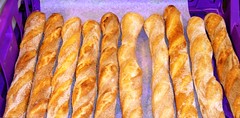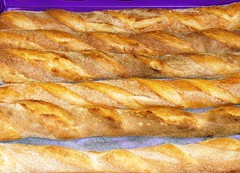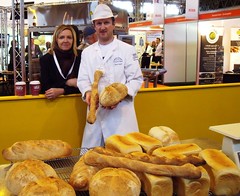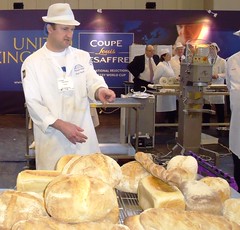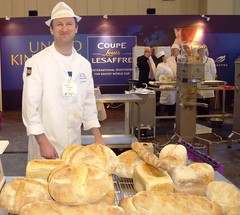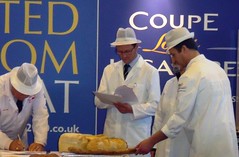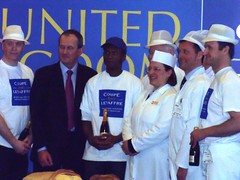Taking Part in a Baking Competition
Way back in early January, not long after I first started posting on TFL, I found an invitation in my e-mails to compete in what becomes the baking world cup: La Coupe du Monde de Bolangerie, next taking place in 2012..
At the international qualification stage, this is known as the Louis Lesaffre Cup http://www.coupelouislesaffre.com/ with the European part set to take place in Paris in 2011. This sounded quite interesting, so I thought I'd give it a go. An e-mail enquiry suggested I would have to make baguettes, a tinned loaf, and a speciality loaf of my own. I decided to give it a go, thinking the UK heats were to be held in May, or, June. By that time my teaching commitments will be less, and I should have completed the second module for my MSc in Food policy. So, I entered.
I didn't hear anything more for a few weeks, except confirmation that I was the first applicant, but I would definitely be taking part. Right at the beginning of March I received a phone call from Nick Townend of BFP Wholesale [yeast company owned by Lesaffre here in the UK], informing me the Competition was set for sometime between the 20th and 24th March, at the NEC in Birmingham, live at the Baking Industry Exhibition. Let's just say that this event is HUGE! I'm in the midst of trying to get an assignment complete for my MSc, and I'm already behind schedule, needing a week's extension. Also, I'd put no plans in place to publicise my plans and score some publicity for Newcastle College, where I lecture.
OK; well I'd better not panic, it'll be just fine, I resolve! Better get some practice in, and, sort out some materials. I contacted my colleagues in Kent [see: http://www.thefreshloaf.com/node/16151/working-french-flour ]and they agreed to post up 10kg of their wonderful T65 Campteclair Farine de Tradition. I knew this would be a score on the competition, and had no problem getting permission from the judges to use this flour. I'd put in quite a lot of work to develop a Caraway Rye Bread with Blackstrap Molasses [see: http://www.thefreshloaf.com/node/16273/carawy-rye-bread-black-strap-molasses-superwet-ciabatta-too ] and thought this would be a great choice for my own loaf. For the tinned bread, I had plans to use a seed soaker with a mix of wholemeal and white bread flours.
Then the Rules were finally published on the 12th March! Baguettes were indeed required. One dough using 7kg of flour; half of this to make traditional hand moulded baguettes, the other half to process through a moulding machine. Finished weight of 240g, I calculated this would give me 36 baguettes! And, I'd only got 10kg of flour in the first place. I double-checked, but was told I could only make one dough. I thought I may get away with a dough using Campteclair for the traditional baguettes, then another dough using industrial flour T55 for the machined products. No go on this. Tinned loaves: 3 x 800g finished weight of White Farmhouse, White Sandwich Tin, and Wholemeal. You can't get much more ordinary than this, but I knew I could at least use sponge and dough methods to get some interesting flavours. The loaf of choice was also something of a letdown. Clearly the judges had made moves to keep the competition as "English" as possible...you can all draw your own conclusions on what that implies! Two from Cottage, Bloomer and Cob loaves; 3 x 800g and 400g finished weights; all white flour. A minimum of 1 hour bulk ferment was stipulated, but no mention made of overnight fermentation. For all these products, Lesaffre bread improvers were available, as were their dry sour preparations!!
Well, I was starting to feel somewhat disheartened by now; seriously I was thinking I should pull out. But a hotel room was booked and paid for by Lesaffre, and I was just about psyched up for the competition side of the whole event. I needed to talk to some colleagues, big-style. Thank you to Eric Hanner of TFL who from this point on was of sterling support. My line manager at work also stepped up and gave me loads of positives. It was great to have word from Jeffrey Hamelman, explaining some of the rationale behind aspects of the rules [he will be judging in Paris, I guess], but also obviously uninspired by the English choices of bread available to me.
So I frantically began e-mailing through to Nick Townend, establishing whatever I could to know it would all work on the day. Quite why I had thought the event was in May/June, I really have no idea at all now. I did 3 days of test baking on 15th, 16th and 17th March, in my bakery kitchen, but teaching a host of different classes at the same time; so, it was extremely stressful, and not all my products turned out how I wanted them. Still, I had a load of notes, and the confidence in the methods used and my own knowledge and skill to believe I had everything there to make it all work over the upcoming weekend.
I had a trip to Nottinghamshire on Thursday 18th March to visit "The School of Artisan Food". I had a table seat reserved on the train, so spent the 4 hours tapping away on my wife's laptop to complete all the recipe/formula and methods for each of the breads I was going to make. I had a great day out visiting what is a wholly exciting new venture, and, I got all this planning work completed too.
Back to College on Friday, to teach a practical baking class, and gather a whole load of equipment and materials together to take to Birmingham. I slept badly on Friday night, and was up by 5am tapping away on my pc, and catching up with the latest from Eric to help me through. The drive to Birmingham is over 250 miles from where we live in the very far north of England. We made very good time, and checked in to the hotel by mid afternoon. My wife, Alison, went shopping, and I went off to the NEC to make my starter doughs for the next day.
I arrived at the NEC, eventually checked into the right Exhibition Hall with all my stuff, and it was bedlam. Everyone was working like crazy to have the Hall set up for the next day. Our "live area" was hardly in any state at all. There was no baguette moulder, and the equipment available was not really set up, and we had to share it with the Bakels/Rondo team doing live demonstrations in the same cordon. Well, no machine-moulded baguettes anyway. Having met all the co-ordinators who were supporting us, the 3 competitors, we then had one hour to make all our overnight ferments. I had 4 to make!
Anyway, mission accomplished and back to the hotel. Alison and I made an exit from the hotel to a decent restaurant, so we could get a break from all things bakery competition for a while at least. I drank just a few beers, and ate some good food, but we went straight to bed on return. I had an early rise, as the Competition kicked off at 7am.
We were there early and away by 06:50, with 8 hours to complete all our loaves. Counting against all of us was the equipment. One of the ovens was low-crown, and we had a lot of tinned breads to make; there was a massive shortage of proving space; we had only one spiral mixer between the 3 of us; the benches we were given were absolutely tiny, and far from robust. And I discovered the wholemeal flour we had been given was really not up to much.
Well, we were on view to one and all, and I want to say thanks to all those who came past and took such an interest in what I was doing: especially Mr. Tony Jenkins from Soothills Bakers in Hampshire. He was fascinated that a baker had turned up at a bakery competition prepared to make very simple products using long fermentation methods only, and no improvers. I was glad to find I wasn't the only one. Stephen Salt from Tameside College, near Manchester, was on a similar mission; the other baking competitor was Andrew Iyare from London. There were 2 competitors on the following day, one being Emmanuel Hadijandreou from Judges Bakery, the other was Wayne Caddy who is a bakery consultant based in Rotherham. I met up with Emmanuel after the competition, which was great; I've been wanting to meet him for a good while. I know Wayne from my time at Leeds Thomas Danby, as he studied there as well, although some years before me.
The competition was pretty stressful at times. The lack of equipment was difficult for all of us, and it was difficult to stay organised throughout. We all managed to work well together, and the support from the co-ordinators on the day was much appreciated. Andrew had finished in very good time. Stephen baked his baguettes last of all, then he was finished too. So I had the run of the ovens at the end, which was a bonus. This was when I discovered that the Tom Chandley deck oven was low crown, so my tinned loaves were getting a bit stuck on the top heat bars! I'd taken longer than the others quite deliberately; this had given me 4 hours to prove the baguettes in the chiller following a one hour bulk fermentation.
The Judging Panel had emerged, and I met up with Colin Lomax from Rank Hovis again. I met him a few years ago at one of Rank's mills in Selby, North Yorkshire. The current NA President was on the panel, with Peter Lonnican from Blackpool, and Sarah Auton, who had been helping to co-ordinate the whole thing. All 4 were very supportive, and full of positive comments for our hard work. I set my 18 baguettes on the sole of the oven with a trusty baguette peel specially made for me at the College, using some coarsely ground semolina from a local organic mill in Northumberland. I had hoped for a little more proof, but they were so easy to handle, and baked up so crispy in the best deck oven I've worked on in years. "Best bread of the day" was Colin Lomax's comment. It was worth competing for that moment alone. I didn't win the event. That honour went to Wayne; my congratulations to him. He gained the place in the UK team for bread baker. The other places are for a Vienoisserie expert, and for someone to do a decorative dough piece.
I've attached a load of photos from the day, and all the recipes and methods used. I've already given thanks for support above, but would like to add to this list. My wife, Alison, took all these photos, bar one obvious one. She accompanied me all the way to Birmingham and back, and supported and encouraged me all the way. Also, Mary and Nigel in supplying me the special T65 flour, gave me a chance to put over at least one really top class product. The white cobs were very fine too, and the sandwich loaves were just about up to scratch. The wholemeal was poor, and I learnt a lot from this. I would always take my own preferred choice of flours to a competition in future. Trying to achieve 72% hydration, and mix in a planetary machine were big mistakes; the BFP flour was not the same spec as the Carrs Mill Race Wholemeal I use in College. The bloomers "got away on me". They tasted fantastic, but looked a little bit too ragged.
I'd made 52 loaves in a pretty stressful situation..but, I d had a thoroughly good time and felt totally at home in this rather strange environment. I want to do this again; it was a lot of fun. Next time I'll be a lot more organised in the run-in!
WHOLEMEAL TINNED BREAD
|
Material
|
Formula [% of flour]
|
Recipe [grams]
|
Recipe [grams]
|
|
1. Quarter Sponge
|
|
|
|
|
Wholemeal Flour
|
25
|
1750
|
875
|
|
Water
|
17
|
1190
|
595
|
|
Fresh Yeast
|
0.2
|
14
|
7
|
|
TOTAL
|
42.2
|
2954
|
1477
|
|
|
|
|
|
|
2. Final Dough
|
|
|
|
|
Quarter Sponge [from above]
|
42.2
|
2954
|
1477
|
|
Wholemeal Flour
|
75
|
5250
|
2625
|
|
Salt
|
1.8
|
126
|
63
|
|
Fresh Yeast
|
2.5
|
175
|
87.5
|
|
White Fat
|
1.8
|
126
|
63
|
|
Water
|
55[max]
|
3850
|
1925
|
|
TOTAL
|
178.3
|
12481
|
6240.5
|
Method:
- Make the sponge the day before; DDT 21°C. Mix 3 mins on speed one. Store ambient, covered in lightly oiled bowl.
- Autolyse flour and water for half an hour.
- Combine sponge, autolyse plus salt, fat and yeast and mix the final dough 2 minutes on first speed, and 6 - 8 minutes on second speed. DDT 24°C
- Bulk Ferment, covered in an oil-lined container for 40 minutes, ambient. Knock back and rest 10 minutes.
- Prepare tins, and scale and divide the dough into 950g pieces. Mould round and rest covered for 10 minutes.
- Shape and pan the loaves
- Proof at 31°C, 85% rH for approx 1 hour; ensure oven set and pre-heated
- Bake to the following profile: Use a deck oven set at 235°C, top heat 6 and bottom heat 8. Use steam set at 2 and keep the damper closed for the first 25 minutes. Check after 18 minutes, turn the loaf pans round if necessary, and drop the heat to 225°C. Open the dampers after 25 minutes, drop the heat to 220°C and bake a further 5 - 8 minutes.
- De-pan and cool on wires.
WHITE COB AND BLOOMER
|
Material
|
Formula [% of flour]
|
Recipe [grams]
|
|
1. Eighth Sponge
|
|
|
|
Strong White Flour
|
12.5
|
875
|
|
Water
|
7.5
|
525
|
|
Fresh Yeast
|
0.1
|
7
|
|
TOTAL
|
20.1
|
1407
|
|
|
|
|
|
2. Final Dough
|
|
|
|
Eighth Sponge [from above]
|
20.1
|
1407
|
|
Strong White Flour
|
87.5
|
6125
|
|
Salt
|
1.8
|
126
|
|
Fresh Yeast
|
2.4
|
168
|
|
White Fat
|
1.0
|
100
|
|
Water
|
55.5 [max for 63% hydration]
|
3675 [60%]
3885 [63%]
|
|
TOTAL
|
168.3
|
11811
|
Method:
- Make the sponge the day before; DDT 21°C. Mix 3 mins on speed one. Store ambient, covered in lightly oiled bowl.
- Autolyse flour and water for half an hour.
- Combine sponge, autolyse plus salt, fat and yeast and mix the final dough 3 minutes on first speed, and 3½ - 5 minutes on second speed. DDT 24°C
- Bulk Ferment, covered in an oil-lined container for 1¼ hours, ambient. Knock back and rest a further 10 mins.
- Prepare trays with silicone paper dusted with semolina for bloomers, and banneton with white flour for cobs, and scale and divide the dough into 950g pieces for large laves and 480g pieces for small. Mould round and rest covered for 10 minutes.
- Shape the loaves, tray up the bloomers, and turn the cobs upside down into the banneton. Recipe yields 4 large and 3 small of each product.
- Proof at 31°C, 85% rH for approx 1 hour; ensure oven set and pre-heated.
- Bake to the following profile: Use a deck oven set at 225°C, top heat 7 and bottom heat 5. Use steam set at 4 and keep the damper closed for the first 15 minutes. Use a peel to set the loaves on the sole of the oven; bloomers on silicone, cut whole surface with angled cuts; cobs tipped onto the peel then transfer to oven after cutting, cross shape over whole floured surface. Check after 20 minutes, to see if the small loaves are baked, Open the dampers and bake a further 8 minutes.
- De-pan and cool on wires.
WHITE TIINNED BREAD: FARMOUSE and SANDWICH LOAVES
|
Material
|
Formula [% of flour]
|
Recipe [grams]
|
|
1. Third Sponge
|
|
|
|
Strong White Flour
|
33.3
|
2331
|
|
Water
|
20
|
1400
|
|
Fresh Yeast
|
0.3
|
21
|
|
TOTAL
|
53.6
|
3752
|
|
|
|
|
|
2. Final Dough
|
|
|
|
Third Sponge [from above]
|
53.6
|
3752
|
|
Strong White Flour
|
66.7
|
4669
|
|
Salt
|
1.8
|
126
|
|
Fresh Yeast
|
1.7
|
119
|
|
White Fat
|
1.8
|
126
|
|
Water
|
43[max]
|
3010
|
|
TOTAL
|
168.6
|
11802
|
Method:
- Make the sponge the day before; DDT 21°C. Mix 3 mins on speed one. Store ambient, covered in lightly oiled bowl.
- Autolyse flour and water for half an hour.
- Combine sponge, autolyse plus salt, fat and yeast and mix the final dough 3 minutes on first speed, and 3½ - 5 minutes on second speed. DDT 24°C
- Bulk Ferment, covered in an oil-lined container for 40 minutes, ambient. Knock back and rest 10 minutes.
- Prepare tins, and scale and divide the dough into 12 x 950g pieces. Mould round and rest covered for 10 minutes.
- Shape and pan the loaves; makes 6 as sandwich loaves and 6 as farmhouse
- Proof at 31°C, 85% rH for approx 1 hour; ensure oven set and pre-heated. Be ready to bake the sandwich ahead of the farmhouse, as these loaves do not need full proof. Lid the sandwich loaves first; dust the farmhouse loaf tops with white flour, and use a single slash, the full length of the loaf.
- Bake to the following profile: Use a deck oven set at 235°C, top heat 6 and bottom heat 8. Use steam set at 2 and keep the damper closed for the first 25 minutes. Check after 18 minutes, turn the loaf pans round if necessary, and drop the heat to 225°C. Open the dampers after 25 minutes, drop the heat to 220°C and bake a further 5 - 8 minutes.
- De-pan and cool on wires.
TRADITIONAL BAGUETTES MADE WITH A POOLISH
|
Material
|
Formula [% of flour]
|
Recipe [grams]
|
|
1. Poolish
|
|
|
|
Campteclair T65 Farine de Tradition
|
33.3
|
2331
|
|
Water
|
33.3
|
2331
|
|
Fresh Yeast
|
0.3
|
21
|
|
TOTAL
|
66.9
|
4683
|
|
|
|
|
|
2. Final Dough
|
|
|
|
Poolish [from above]
|
66.9
|
4683
|
|
Campteclair T65 Farine de Tradition
|
66.7
|
4669
|
|
Salt
|
1.8
|
126
|
|
Fresh Yeast
|
0.9
|
63
|
|
Water
|
32.7
|
2289
|
|
TOTAL
|
169
|
11830
|
Method:
- Make the sponge the day before; DDT 21°C. Mix 3 mins on speed one. Store ambient, covered in lightly oiled bowl.
- Autolyse flour and water for half an hour.
- Combine sponge, autolyse plus salt and yeast and mix the final dough for 9 minutes on first speed. DDT 24°C.
- Scale the dough into 2 equal portions. Bulk ferment both portions in oil-lined, covered bowls for 40 minutes.
- Scale the first portion into 18 x 325g pieces and mould round. Rest covered for 10 minutes. Meanwhile, scale the other dough portion into 18 x 325g pieces, and mould round. Store these covered in the chiller for 2 hours.
- Once rested, roll out the 18 pieces from the first batch of dough, using a baguette moulder, to 60cm. Place these onto stick wires and set to prove; 35°C, 85% rH, for 45 mins to 1 hour approx. Use 6 diagonal cuts just prior to baking.
- Bake as follows: deck oven, full steam; 240°C, top 6.5, bottom 5, for 20 minutes. Turn the heat down to 225°C, for 5 minutes. Open the damper and turn the heat to 215°C and bake a further 5 - 7 minutes.
- Cool on wires
- For the second batch, gradually and carefully, roll each piece out by hand to 60cm. Set to prove, ambient, en coûche and well covered with cloth and plastic. Use semolina, as dust, as required. Try to keep the seal of each baguette on the bottom. Prove approx 1 hour. Cut each loaf using a grignette, 6 diagonal slashes. Set on the sole of the oven using a baguette peel.
Bake profile: as for the first portion of baguettes. Cool on wires



